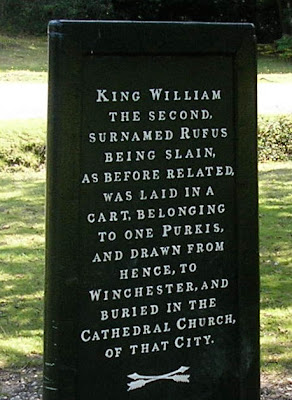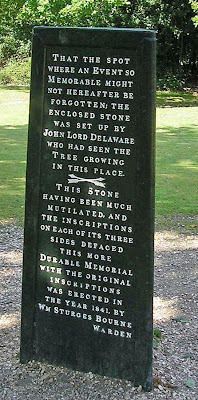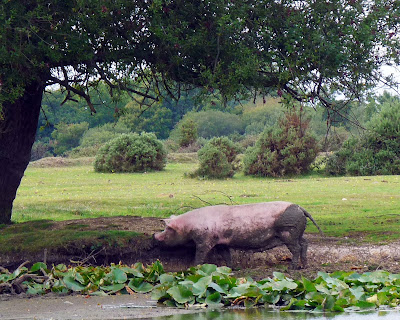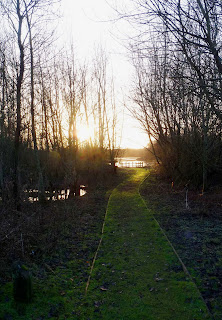


"Here stood the oak tree,
on which an arrow shot by Sir Walter Tyrrell at a stag,
glanced and struck King William the Second,
surnamed Rufus on the breast,
of which he instantly died,
on the second day of August, ANNO 1100."
The Rufus Stone, stands in a shady glade in the New Forest in Hampshire, UK, set back from the A31 road, near the village of Minstead.glanced and struck King William the Second,
surnamed Rufus on the breast,
of which he instantly died,
on the second day of August, ANNO 1100."
The stone memorial has three faces (and is a bit like a trig point). It was erected in honour of King William II, aka as William 'Rufus', son of William the Conqueror by John, Lord Delaware (who had seen the oak tree) in 1745. The Conqueror's son died in the immediate vicinity on 2 August 1100 as a result of an arrow fired by Sir Walter Tyrrell. The killing was said to be an accident rather than a murder. On hearing the news, Henry, the youngest brother of the departed monarch, was hurriedly proclaimed king by the barons, in a bid to beat his eldest brother, Robert of Normandy, to the throne of England.
The bones of William 'Rufus' lie in a mortuary chest (press link, then scroll down) in Winchester Cathedral, along with those of other members of the Royal Family, such as King Cnut and his wife, Emma. You may be wondering how the body turned up in Winchester for burial. A man known as 'one Purkis' laid the royal corpse in a cart and took it to the cathedral city. The original Rufus Stone became defaced and hard to read: a replacement memorial was erected in 1841.
The New Forest today is a wildlife paradise. The following species of vertebrates and invertebrates can be found: ponies, deer, cattle, badgers, foxes, donkeys, bats, mice, water voles, adders, grass snakes, owls, warblers, curlews, spiders and butterflies. The ponies, donkeys and cattle belong to commoners, who receive grazing rights for a small fee. I imagine that there is a similar arrangement for pigs and sheep.

There are also many species of tree, e.g. oak, beech, holly, sycamore, alder, ash, silver birch, sweet chestnut, horse chestnut, crab apple, blackthorn, hawthorn, viburnham, whitebeam, pine, redwood and yew. Some of the trees are very special: you can read here about the Knightwood Oak, the Adam and Eve Oaks and the Eagle Oak. Wouldn't it be wonderful if the White-Tailed ('Sea') Eagles returned, albeit with a bit of help? We so enjoyed watching these magnificent birds on the Scottish islands of Skye and Raasay last summer. There was great excitement in 2009 when a new kind of fungus, a yellow form of Phellodon melaeucus, was discovered in the New Forest. The fact that this area has been managed in traditional 'commoning' ways, without the intensive use of artificial fertilizers and chemicals may contribute to the amazing biodiversity and number of rare species.
- What exactly is the New Forest?
- What of its history? and here.
- Find out about the ornamental and historic trees in the forest.
- The Forestry Commission - and the Rufus Stone
- About 'The Children of the New Forest' by Captain Marryat
- BBC Autumnwatch: the New Forest featured in a number of stories e.g. like these from 2008.




























